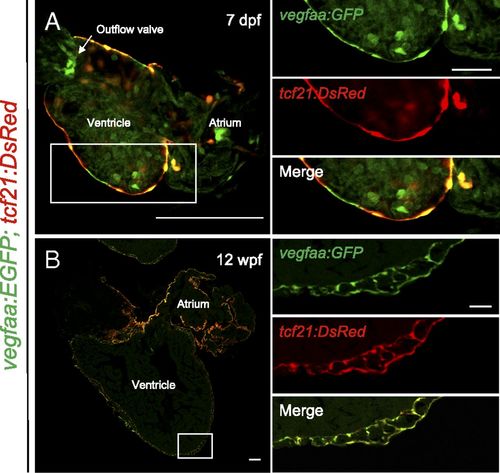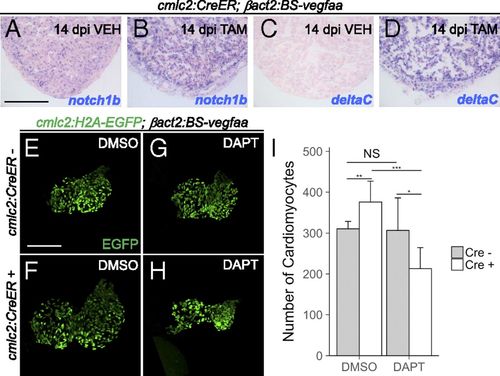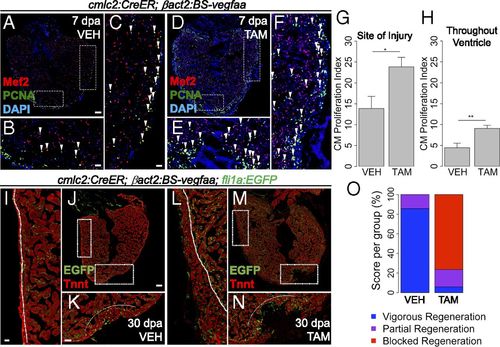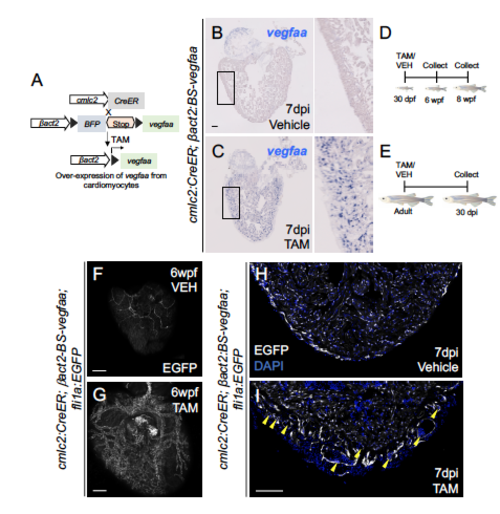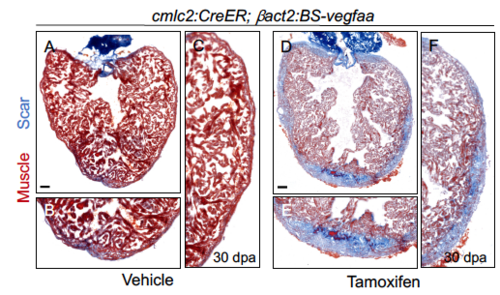- Title
-
Vegfaa instructs cardiac muscle hyperplasia in adult zebrafish
- Authors
- Karra, R., Foglia, M.J., Choi, W.Y., Belliveau, C., DeBenedittis, P., Poss, K.D.
- Source
- Full text @ Proc. Natl. Acad. Sci. USA
|
vegfaa expression during zebrafish heart development and homeostasis. Tiled images of vegfaa:EGFP;tcf21:DsRed cardiac sections during (A) larval and (B) adult stages. Sections are immunostained for EGFP. Boxes correspond to the region magnified in adjacent panels. (Scale bars: A and B, Left, 100 ?m; A and B, Right, 25 ?m.) |
|
vegfaa expression during adult zebrafish heart regeneration. (A and B) Colocalization of vegfaa:EGFP and kdrl:DsRed expression in hearts without injury and at 3 dpa. (C and D) vegfaa:EGFP expression in an uninjured heart and a heart 7 d post CM ablation (dpi). (E and F) vegfaa:EGFP expression in an uninjured heart and a heart after 14 d (dpi) of nrg1 overexpression. Arrows indicate EGFP+ endocardial cells. Boxes correspond to the region magnified in adjacent panels. [Scale bars: A, C, and E, 100 ?m (Left) and 25 ?m (Right); scale bars correspond to B, D, and F, respectively.] |
|
Effects of cardiac vegfaa overexpression in the absence of injury. (A?D) Tiled images of cmlc2:CreER;?act2:BS-vegfaa;fli1a:EGFP hearts at 6 wpf and 8 wpf after treatment with vehicle or tamoxifen at 30 dpf. (E and F) Tiled images of adult cmlc2:CreER;?act2:BS-vegfaa;fli1a:EGFP hearts 30 dpi with vehicle or tamoxifen. Sections are immunostained for Tnnt. Boxes correspond to the region magnified in adjacent panels. Blue lines approximate the CM primordial layer and blue arrows denote ectopic vasculature. (G?I) Maximum thickness of the Tnnt+ compact layer at 6 wpf after treating 30-dpf fish with vehicle (n = 11) or tamoxifen (n = 6); at 8 wpf after treating 30-dpf fish with vehicle (n = 11) or tamoxifen (n = 9); and at 30 dpi after treating adult fish with vehicle (n = 5) or tamoxifen (n = 6). Error bars indicate SD (**P < 0.01 and ***P < 0.001, Student?s t test). (Scale bars: A?F, Left, 100 ?m; A?F, Right, 25 ?m.) |
|
Cardiac vegfaa overexpression elicits an ectopic heart regeneration program. (A and B) Tiled images of cmlc2:CreER;?act2:BS-vegfaa hearts 14 dpi with vehicle or tamoxifen. Arrowheads indicate Mef2+/PCNA+ nuclei. Mef2?/PCNA+ nuclei are likely to be cycling epicardial cells, endothelial cells, fibroblasts, or inflammatory cells. (C) CM proliferation 14 dpi with vehicle (n = 10) or tamoxifen (n = 8). Error bars indicate SEM (***P < 0.001, Mann?Whitney U test). (D and E) cmlc2:CreER;?act2:BS-vegfaa;gata4:EGFP hearts 14 dpi with vehicle or tamoxifen. Arrowheads indicate gata4+ CMs. (F and G) Images of cmlc2:CreER;?act2:BS-vegfaa;LENP2:EGFP hearts 14 dpi with vehicle or tamoxifen. Arrowheads indicate LENP2+ cells. Tnnt marks CMs. Boxes correspond to the region magnified in adjacent panels. (H and I) Images of cmlc2:CreER;?act2:BS-vegfaa;tcf21:DsRed hearts 14 dpi with vehicle or tamoxifen. (J and K) In situ hybridization for raldh2 on ventricular sections. Violet staining indicates expression. [Scale bars: B, H, and J, 100 ?m (also apply to A, I, and K, respectively); D and F, 100 ?m (Left) and 25 ?m (Right) (also apply to E and G, respectively).] |
|
Dependence of vegfaa-induced CM hyperplasia on Notch signaling. (A?D) In situ hybridization for notch1b and deltaC on cardiac sections from cmlc2:CreER;?act2:BS-vegfaa animals 14 dpi with vehicle or tamoxifen. Violet staining indicates expression. (E?H) Maximum-intensity projections of 7 dpf hearts from cmlc2:H2A-EGFP;?act2:BS-vegfaa fish with or without an additional cmlc2:CreER transgene. Animals were first treated with 4-HT, followed by DMSO (n = 9 for Cre? animals and n = 10 for Cre+ animals) or DAPT (n = 8 for Cre? animals and n = 9 for Cre+ animals). (I) Number of CMs at 7 dpf for treatment groups shown in E?H. Error bars indicate SD (*P < 0.05, **P < 0.01, and ***P < 0.001, Student?s t test). NS, not significant. [Scale bars: A and E, 100 ?m (also apply to B?D and F?H, respectively).] |
|
Effect of vegfaa overexpression on heart regeneration. (A?E) Tilescan images of cmlc2:CreER;?act2:BS-vegfaa hearts at 7 dpa after treatment with vehicle or tamoxifen. Boxes mark the regions at the injury site (B and E) and away from the injury site (C and F). Arrowheads indicate Mef2+/PCNA+ nuclei. PCNA+ nuclei that do not colocalize with Mef2 are likely to be cycling epicardial cells, endothelial cells, fibroblasts, or inflammatory cells. (G and H) CM proliferation adjacent to the wound (G) and throughout the ventricle (H) at 7 dpa and after treatment with vehicle (n = 8) or tamoxifen (n = 12). Error bars indicate SEM (*P < 0.05 and **P < 0.01, Mann?Whitney U test). (I?N) cmlc2:CreER;?act2:BS-vegfaa;fli1a:EGFP ventricles at 30 dpa. Tnnt marks CMs. Boxes mark the regions at the injury site (K and N) and away from the injury (I and L). Dashed lines in K and N approximate the resection plane. Dashed lines in I and L indicate the boundary of trabecular muscle and compact muscle. (O) Regeneration scores at 30 dpa after treatment with vehicle (n = 14) or tamoxifen (n = 17; P < 0.001, Kruskal?Wallis test). [Scale bars: A and J, 100 ?m (also apply to D and M, respectively); B, C, I, and K, 25 ?m (also apply to E, F, L, and N, respectively).] |
|
vegfaa:EGFP expression in larval and adult fish. (A-B) Tile-scanned, maximum intensity projection of the trunk of a kdrl:DsRred fish and a vegfaa:EGFP; kdrl:DsRred fish at 3 dpf. Boxed region corresponds to the magnified region shown in the adjacent panel. (C-E) Tiled images of vegfaa:EGFP hearts without injury, at 3 days post amputation (dpa), and at 7 dpa. Sections were immunostained with for EGFP and Tnnt. Boxed region corresponds to the magnified region shown in the adjacent panel. Curved lines approximate the amputation plane. (Scale bars 100 ?m) |
|
Transgenic overexpression of vegfaa from cardiomyocytes. (A) Transgenic approach to overexpress vegfaa from cardiomyocytes. (B-C) In situ hybridization for vegfaa on sections from ventricles of cmlc2:CreER; ?act2:BS-vegfaa animals 7 days post incubation (dpi) with vehicle or tamoxifen. Violet staining indicates expression. Boxed region corresponds to the magnified region shown in the adjacent panels. (D-E) Schematic depicting juvenile and adult experiments in Figure 3. (F-G) Tile-scanned images of ventricular surfaces from cmlc2:CreER; ?act2:BS-vegfaa; fli1a:EGFP fish at 6 wpf following incubation with vehicle or tamoxifen at 30 dpf. (H-I) Tile-scanned images of sections from ventricles of cmlc2:CreER; ?act2:BS-vegfaa; fli1a:EGFP animals 7 days after treatment with vehicle or tamoxifen. Yellow arrows indicate nucleated blood cells in the lumen of ectopic blood vessels. (Scale bars 100 ?m) |
|
Cardiac vegfaa overexpression induces markers of EMT. In situ hybridization for snai2 (A-B), twist1 (C-D), and pdgfrb (E-F) on sections from ventricles of cmlc2:CreER; ?act2:BS-vegfaa animals 14 days after treatment with vehicle or tamoxifen. Violet staining indicates expression. (Scale bars 100 ?m) |
|
Cardiac vegfaa overexpression causing scarring after ventricular resection. Picro-Mallory staining of regenerating hearts overexpressing vegfaa. Tiled, brightfield images of sections from control animals show limited collagen (blue) at the site of injury and within the ventricular wall (A-C). By contrast, animals overexpressing vegfaa have scar at the resection site and throughout the ventricular wall (D-F). (Scale bars 100 ?m) |

